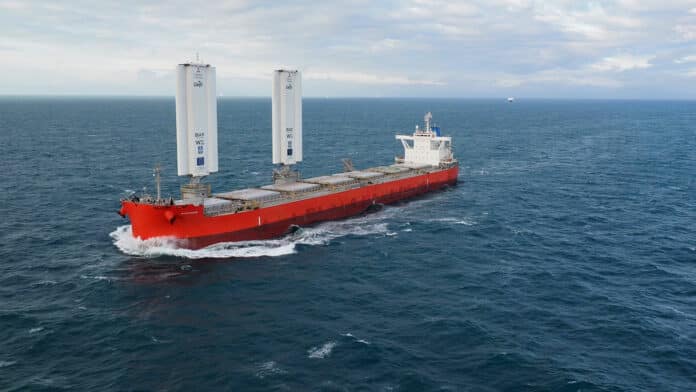Cargill revealed exciting results from the six-month test period of the Pyxis Ocean, underscoring the potential for wind-assisted propulsion technology to move the shipping industry toward renewable energy use.
The successful test period of the MC Shipping Kamsarmax vessel with two WindWings – large solid wind sails developed by BAR Technologies – could potentially be a game-changer in reducing fuel consumption and emissions. The vessel has achieved performance consistent with what was predicted, which is equivalent to an average of 3 tonnes of fuel per day.
The Pyxis Ocean hit open waters in August 2023 and has already sailed the Indian Ocean, Pacific Ocean, North and South Atlantic, and passed Cape Horn and the Cape of Good Hope. The ship has been retrofitted with two WindWings measuring 37.5 meters in height and resembling large airplane wings.
The wings are installed vertically to catch the wind and propel the ship forward. By using this technology, the ship’s engine can be turned down, and it can travel at the same speed as a conventional ship while using less fuel.
The installation of WindWings, which are controlled by a touch panel on the bridge, has significantly reduced the ship’s fuel consumption while maintaining the same speed as a conventional ship. The sails are fully automated and self-adjust to the optimal configuration based on the wind sensors. The crew is alerted to raise or lower the sails with a simple traffic light system.
BAR Technologies and Cargill estimate an annual average savings of 3 tonnes of fuel reductions per day, which translates to 11.2 tonnes of CO2e well-to-wake emissions reductions. The average performance measured so far is within 10% of predictions made using computational fluid dynamics simulations.
During optimal sailing conditions, the Pyxis Ocean achieved fuel consumption savings of more than 11 tonnes per day, which translates to 41 tonnes per day less CO2e emitted well-to-wake, or a 37% emissions savings. The estimated average of 11.2 tonnes of CO2e per day is equivalent to removing 480 cars from the road.
Wnd-assisted propulsion has the potential to be a cost-efficient way of supporting the International Maritime Organization’s (IMO) new greenhouse gas strategy. The IMO’s 2030 targets aim to have 5 percent, striving for 10 percent, of energy, coming from very low carbon sources by 2030, and wind-assisted propulsion could be an important way of achieving this goal.
In addition to the application of sails on a vessel, the early voyages have highlighted broader logistical challenges in the global maritime system. Since every port, terminal, and berth is different, their involvement is critical to integrating Wind-Aided Propulsion (WAP) technology into the global maritime system on a wider scale.
“The results of the Pyxis Ocean’s first voyage with WindWings installed clearly demonstrate that wind-assisted propulsion can secure significant fuel savings and emissions reduction. For example, during an open sea voyage in near optimum sailing conditions, the Pyxis Ocean achieved fuel savings of 11 tonnes per day,” John Cooper, BAR Technologies CEO, added. “And while the Pyxis Ocean has two WindWings, we anticipate the majority of Kamsarmax vessels will carry three wings, further increasing the fuel savings and emissions reductions by a factor of 1.5. With Cargill now able to validate our performance predictions and modeling in real-world conditions, it’s an exciting time as we begin to roll out WindWings production globally.”
Cargill will continue testing and experimenting with the operational, technical, and commercial aspects of the Pyxis Ocean to incorporate the maximum amount of learning into the potential design of future installations before scaling up.
